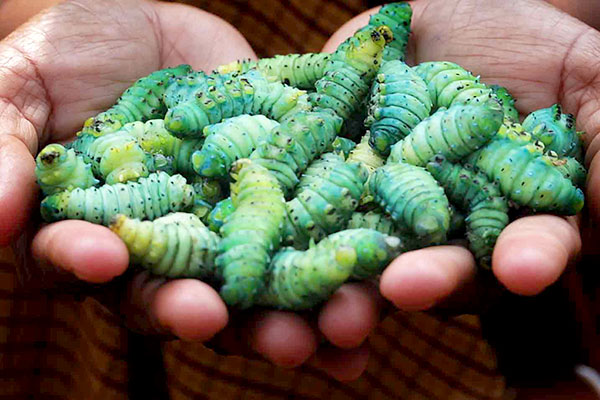Eri silkworms are domesticated silkworms, found in North East India, locally known as ‘Niang Ryndia. These silkworms feed mainly on castor leaves. They are the source of our Ryndia garments which are worn on traditional festivals and occasions. Eri silkworms also are a part of the tribal cuisine. They are delicious and nutritious; rich in proteins and a good source of minerals. These silkworms are one of the cleanest foods, as they grow feeding only on castor leaves. Therefore, they are healthy to eat and chemical free. These silkworms are cultivated and consumed in summer.
Since we are all very conscious of what we eat and where our food comes from, here’s a little information on how eri silkworms grow in Ri Bhoi District, Meghalaya and how healthy it is to be included in our diet.
The farmers select the right eri silkworm cocoon and tie them to tree branches having lots of leaves and wait till it starts to turn into a moth. Once it forms into a moth, it’s tied to a white cloth so it won’t fly off. This moth will lay its eggs. Once they eggs are laid, they are transferred to a pdung (a pdung is a round tray made of tried bamboos). When the eggs have hatched into a larva, they are fed with castor leaves for a period of two weeks. There will be a stage where the larva will consume the most amounts of leaves; this will indicate that the larva is preparing to form a cocoon around itself. When it starts forming a cocoon, they are checked by the sound it makes when touched. If on touching the cocoon, a hollow sound is heard, they are immediately taken and tied with a string to tree branches with abundant amount of leaves which have been previously cut. The tree branches are kept in one corner and inspected from time to time. Within 2-3 weeks these cocoons are fully wrapped, at this time the silkworms are removed from the branches before they turn into caterpillars.
The farmers then separate the silk from the worm by hand, ensuring they don’t cut with a knife or scissor. These silkworms are then sold in the markets for consumption.
The locals from Ri Bhoi District cook different dishes with these eri silkworms like ‘Niang Ryndia Tham Tungtap’ (Eri silkworms’ chutney with crabs), ‘Niang Ryndia Nei-iong bad Lungseij (Eri silkworms curry with black sesame and bamboo shoot) and many more. These eri silkworms are readily available at markets ranging at different prices. In the markets in Ri Bhoi, they are sold @ Rs.80 per 250gms and @ Rs.320 per kg.
We hope these eri silkworm dishes have aroused your taste buds. We will share more recipes in details in our next article.

